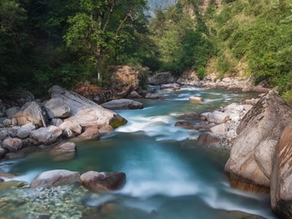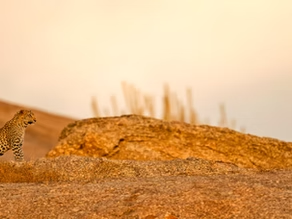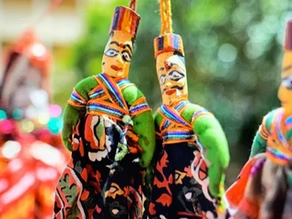A GUIDE TO TIRTHAN VALLEY

The Tirthan River, photographed by Saurav Kundu on unsplash “Listening to the murmur of water or watching the clouds float across the sky, is by no means a waste of time”, the lines were very rightly said by John Lubbock. The clouds, the hills, the waterfalls are just like mother nature’s arms where anyone can find peace and happiness, Tirthan valley happens to be one such hidden jewel of Himachal Pradesh, where peace and happiness come hand in hand. Tirthan valley, the perfect hideaway of the Himalayas, is perched at an altitude of 1600 meters above sea level, in the Kullu district of the state. Tirthan valley happens to be the state’s best-kept secret. So, a treasure hunt is what would be an appropriate term for a vacation here. HOW TO REACH THE START POINT OF THE HUNT? The nearest airport to Tirthan is the Bhuntar Airport, which is 90 minutes away from the valley. The nearest railway station is at Kirtipur which is 7 hours away from Tirthan or the Ambala railway station which is 8 hours away from Tirthan valley. However, the best way to reach here is by road. The roads to Himachal are quite smooth and are connected directly to major cities such as Delhi and Chandigarh. The road trip adds an essence to the trip and also helps you get into the mood for mountains. THE LITTLE TREASURES OF TIRTHAN VALLEY The Tirthan Valley, photographed by Junaid Ahmad Ansari THE GREAT HIMALAYAN NATIONAL PARK The national park happens to be one of the most-visited and most well-maintained treasures. The national park is a UNESCO world heritage site, which adds more value to it. The park was established in 1984 and is spread over an area of 754 sq. km. The place is enriched with a variety of flora and fauna, some of which happen to be exotic. There are about 181 species of birds and 31 species of mammals here. The park is surrounded by lush green landscapes and tall trees. The place happens to be very popular among trekkers, explorers, and enthusiasts. RIVER TIRTHAN The main river flows in the valley. The turbulent river flows through the forests, making its way by slashing rock pieces on the way. The river is a true sight to cherish. The river is also home to the wide known variety of fishes, the trout. People with an interest in fishing and angling tend to visit here. The river crossing is another sport that one can enjoy here. Sitting on the banks of this river and relaxing brings peace to your hearts. SEROLSAR LAKE Serolsar Lake happens to be another attractive yet enchanting stop here. The water of this lake is crystal clear and people around here believe that it is blessed with medicinal properties. The best way to explore the enchanting beauty of the place is to take a walk along the banks of the river. One of the major attractions around here is the Budhi Nagin Temple, which belongs to the Goddess of the forest. The place has a number of oak trees, which makes this place even more mystical, yet picturesque. RAGHUPUR FORT The Raghupur fort is a historical spot present in the Tirthan valley. The place is believed to be constructed by the rulers of the Mandi dynasty to prevent themselves from the attacks of the invaders. However, the place is now in ruins, but the remaining walls still narrate the history. The best part here is the panoramic landscape adorned with oak trees and vibrant flowers. The calming environment here serves as a cherry on the top. JALORI PASS Jalori Pass is the most precious gem that one can find here. Situated at an elevation of 10,800 ft. above sea level, the place is one of the most stunning spots to visit. However, the place still remains unexplored but happens to be one of the major destinations on the list of trekkers and travel enthusiasts. The place is nestled in the arms of the Himalayas and is adorned with coniferous trees, ferns, and vibrant flowers. The forest around is home to a number of migratory birds such as the blue robin. Thus, making this place a potential hotspot for bird watchers, photographers, and enthusiasts. The trekking trail here is one of a kind, as one can spot snow-capped mountains, meadows, valleys, and hamlets along the way. CHHOIE WATERFALLS Chhoie waterfalls are one of the most beautiful waterfalls of Himachal Pradesh and are quite a famous stop for trekkers amidst their trekking expeditions. The cascade is breathtaking and is surrounded by rocks and lush greenery. The rumbling sound of the water brings peace and tranquility. BUT WHAT’S A HUNT WITHOUT SOME ADVENTURE Trekking, photographed by Rahul Dey on unsplash The Tirthan valley is home to several activities, in which one can indulge. FISHING AT RIVER TIRTHAN The crystal clear river is home to brown and rainbow-colored trout, thus making it an attractive destination for angling enthusiasts. The weather year is something, which remains favorable throughout the year, making the place even more compatible and attractive. RIVER CROSSING River crossing at Tirthan river is one of the best things to do around here. The place is a hotspot for adventure seekers, who come from all over the world just to explore and satisfy their adrenaline rush, as they cross the river being tied to the safety harness. ROCK CLIMBING Tirthan valley has a number of spots for rock climbing and the activity is loved by many tourists and enthusiasts. Before the actual activity, you would be given some basic training in rock climbing. This activity is conducted by several local operators around here. Sunrise at Tirthan Valley, photographed by Vaibhaw Kumar on unsplash The treasure hunt was indeed a long one. However, the treasures we take home from here are the best. The cool breeze,
JAWAI- THE HIDDEN LAND OF LEOPARDS…….

THE LAND OF LEOPARDS “Rajasthan is a homeland of many legendary figures more than just folk dances and decorated Havelis.“ The state of Rajasthan has always been a home to warriors and kings, home to culture and traditions, but did you know that it also houses the Indian Leopards, one of the most majestic and intimidating animals. These mysterious felines grace the hidden hills of Jawai and disappear into their folds and merge with the lush grasslands, which meet the granite stones on the banks of Jawai River. Jawai is a small village at Abu road tehsil of Sirohi district, located on the banks of the Jawai River, which is known for Jawai Bandh, a famous dam built by Maharaja Umaid Singh of Jodhpur. The place is away from the hustle-bustle of the city and offers amazing views of nature. HISTORY OF JAWAI Jawai holds a significant spot in our history, which is dated back to prehistoric times. A sage named Maharshi Javali, took a shelter here for meditation during the Vedic age. This village is also one of the make-shift shelters of the Pandavas, during their exile period. Today, the village is home to the Rabari tribe, which is believed to have been born from Goddess Parvati, these tribes hence worship goddess Parvati and follow a matriarchal system, where most decisions are taken by the women. These people share a special relationship with animals and continue living nomadic life. HOW TO REACH JAWAI? HOW TO REACH JAWAI? By Road:- Jawai is well-connected to all the major cities of Rajasthan by roads such as Udaipur, Jaipur, Jodhpur, and Mount Abu. By Rail:- There are three railway stations near Jawai, all of which are connected to major cities such as Mumbai, Delhi, and Ahmedabad. The Mori Bera Station, The Jawai Bandh Station and, The Faalna station. By Air:-The nearest airports to Jawai, are located in Udaipur, Jaipur, and Jodhpur. After which you can take a cab or a bus to travel further. PLACES TO VISIT IN JAWAI THE EVER-SO FRIENDLY JAWAI LEOPARDS LEOPARD (Image Credit:- Adaivorukamuthan on unsplash) The leopards and the people of Jawai share a strong and warm relationship, Jawai, not being a conserved wildlife sanctuary should have been prone to leopard attacks, but over the years there has been no such attack, which happens to be fascinating. The story of Jawai has been a success, with the efforts of the people the leopard number had witnessed a rise, within a few years. Since there were no cases of man-animal conflict, the leopards and human beings lived quite harmoniously. Jawai is blessed with picturesque hills and grasslands, surrounded by water, which qualifies it as a perfect environment for leopards to thrive. The place has the highest density of leopards in India and there are frequent sightings of this majestic feline. THE PICTURESQUE GRANITE HILLS THE GRANITE HILLS The magnificent Jawai hills, also known as the granite hills, are home to animals and humans. Over the years these hills have protected and provided shelter to a wide variety of animals. The Jawai hills are not steep, which makes trekking easier, there are many picturesque locations hidden in these hills, one can easily go ahead and experience the wilderness inside. These hills give you a feeling of solitude and help you relax. A BIRD WATCHER’S PARADISE FLAMINGOS (Image Credit:- Jeet Sandhu on unsplash Jawai interestingly is also home to several native and migratory birds, who find temporary shelter here from October to March. Jawai happens to be the appropriate place for bird watchers and ornithologists to explore and study the traits, gaits, and behaviors of these exotic birds. The birds are dominantly found near the Jawai river. The bird-watching experience in Jawai leaves every spectator spellbound with its charm. The place also happens to be a perfect place for curious photographers who wish to capture these little creatures. There are various species of birds found here which include the Indian Eagle Owl, Indian Robin, Lagger falcon, Shikra, Black-winged Kite, Ruddy Shelduck, Bar-headed Goose, Greater Flamingo, Sarus Crane and, Indian Peafowl. THE CROCS THE CROCS (Image Credit:- Pexels) Crocodiles happen to be another major attraction of Jawai. The presence of water and a variety of birds make this place a heaven for crocodiles. Watching crocodiles in their natural habitat, basking in the sun, and hunting for food, is one of the exciting sights to relish. You can easily spot these creatures near the dam. TRIBAL TRAIL THE RABARI TRIBE Jawai, like many other places of Rajasthan, is home to local tribes, The Rabari Tribe to be specific, who rear cattle and live a life of simplicity. In the modern era, where people are diverted towards the western culture, these people tend to stay attached to the roots of their culture as well as nature. These people are the ones who helped conserve and grow the leopard population here. THE JAWAI BANDH (DAM) THE JAWAI BANDH The dam was built by Maharaja Umaid Singh of Jodhpur, across Jawai River, a tributary of Luni river. The dam is a major source of water for Jodhpur and many areas of the Pali district. This is one of the largest dams in western Rajasthan and has recently become a major attraction for tourists. The Jawai Bandh is also home to the Rabari tribe and a variety of animals. The dam provides a precious and fascinating view of the majestic hills. SPIRITUAL TRAIL Jawai has several spiritual centers, where you can rejuvenate your mind and the soul. The Dev Giri Temple, which is dedicated to Aashapura Mata, the locals believe that this goddess protects them from natural calamities. The temple is a monolith located in between the hills. At first sight, the temple gives you goosebumps and happens to be a mesmerizing sight for people. Many times, leopards can be spotted moving freely around the temple. The Kambeshwar Mahadev Temple, which is located in
RAJASTHAN ON ROAD

THE MESMERIZING ART OF PUPPETRY Ralph Waldo Emerson justly said that “It’s the journey and not the destination”, that matters, so here I take a trip down the memory lane and reminisce about my road trip from The City Of Lakes to The Golden City (Udaipur to Jaisalmer). THE BEGINNING My journey began on a beautiful and cold winter morning, where we all got loaded up in our car, ready to explore the roads while the music and the magnificent Aravali Hills kept us company, while we paved our way out of “Mewar” (the south-central part of Rajasthan). The 490 km long journey was no less than an adventure, as we got a chance to experience the grandeur of the majestic mountains, the spectacular landscapes, and the glowing dunes. After a 5- hour not-so-tiring journey we bid goodbye to the serene views of Mewar and landed in “Marwar” (south-western part of Rajasthan), The word itself means, “The Land of Deserts”. Here, we began our journey to explore the real Rajasthan in its raw form, the state of Marwar, welcoming us with its beautiful colors and prints, which is the essence of Rajasthan. People adorned in beautiful turbans and women with the authentic traditional “lehengas”, left us in awe of them. Read more about travel experience in Rajasthan in the blog written by Sophie THE MUST VISIT STOPS You won’t imagine such a temple exists! While drooling over the amazing culture and heritage of the state we paved our way and reached our first destination, THE BULLET BABA TEMPLE, located about 40kms from Jodhpur. Here, the devotees gather to worship a Royal Enfield Bullet (Motorbike), which is decorated and encased in a glass case. On speaking with the locals here, we got to know that there is a fascinating piece of history associated with this temple. It is said that a local youth, Om Banna died in a motorcycle accident and since then his soul protects people from the same fate. People worship here for a safe journey. Locals also claim that they have seen the ghost of Om Banna! The bike is also believed to have supernatural powers, which intrigued us. I’m not drooling you are!!! After worshipping at the temple, we moved forward and took a stop to enjoy the very famous delicacy of the state, “Kachori“, a seasoned deep-fried bite. It was astounding to watch the oil-dripping kachoris landing directly from the stove on our plates. The burst of flavors in my mouth is something that I will treasure forever. After refreshing ourselves with a blast of flavors, we got back on wheels and moved towards Jodhpur, The capital of the Kingdom Of Marwar, to sink deep into the mysteries, to hear tales of triumphs and battles, to get mixed into the culture and heritage of the city and to surrender to the delicious cuisines the state has to offer. MEHRANGARH FORT (CITADEL OF SUN) Image credits:- Makm Photography on Unsplash) The Sun City We reached Jodhpur at the onset of dusk, where we were welcomed by traditional Rajasthani folk music, which was like a prayer to our ears. The environment was full of soothing lights, bonfires, and melodious tunes. After relaxing in the evening. We started our exploration early next morning, our first destination being the “MEHRANGARH FORT” (Citadel of Sun) which stands on a perpendicular cliff, about 400 feet above the skyline of Jodhpur, is a majestic citadel of colossal proportions. Burnished in red sandstone, the fort presents a strangely haunting yet beautiful view. Walking through the fort and reading the tales of valor made me admire the culture more. The local artists performing at the fort and the beautiful shops added to the beauty of the fort. The fort has an amazing view, which makes me wonder how exciting it would have been to be a king! A little slice of heaven For lunch, we decided to devour the flavors of the city and tried out “Laal Maas”, a mutton curry prepared in a sauce of yogurt and hot spices, along with “Missi Roti”, a Rajasthani bread made of wheat and gram flour. After a sumptuous lunch, we went on to explore the local market, where we enjoyed shopping for souvenirs. For dinner, we enjoyed the famous,” Dhani Dinner”, a village-themed dinner where we enjoyed the local delicacies Kair Sangri, Gatta Curry, Missi Roti, Dal bati churma. The local food was engrossed with a variety of flavors, which played hide and seek with my taste buds. The Golden City After spending the night, we bid goodbye and moved towards the Golden city. A four hour journey which was spent driving through the beautiful roads admiring the beauty of the dunes, we reached our final destination Jaisalmer. JAISALMER FORT (SONAR QILA) We made our first stop at the mesmerizing Jaisalmer Fort, also known as Sonar Qila (Golden Fort). The fort rises from the sand itself and the setting sun adds its magic and shrouds the fort with mystique. It is one of the first living forts of India which has a dwelling of human settlements inside it, giving it a more aesthetic appeal. The fort is adorned with beautiful carvings which depict the culture in a never known way. Ghost Village (Ghost Police on the way!!) We then made our way towards the famous village of Kuldhara, which is also known as the “Ghost Village”, the village is believed to be the home of Paliwal Brahmins, who were forced to leave the village, when they did not submit to the wishes of Salim Ali, who was a powerful prime minister of the state. But, it is believed that the Paliwals cursed the village such that nobody would be able to settle there and to date, the village remains barren. The walls of the houses here depict a story of pain and sadness. The village tells the tales of a struggle adding to the history

